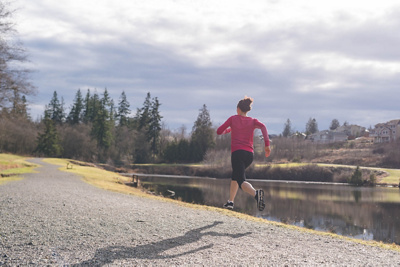Stretching Exercises Infographic (in German)
PDF | 175.69 KB

Whether it is in the woods or along the banks of rivers and lakes, about one million people of all ages run in Switzerland every year. With proper training and a balanced diet, you can sustainably improve your performance.
Here are some valuable tips on how to exercise and start or improve your running in the best possible way. You will also find out the cause of knee pain and how you can start training again after meniscus surgery. Find out more about our specialist centres as well. Our orthopaedic surgeons and sports doctors are available to answer any questions that you may have about sports medicine.
Learn to train correctly for running! The aim is to train as effectively and sustainably as possible to achieve optimum success. However, your health should also be paramount during training; for example, injuries should be prevented.
It is very important to stretch your muscles both before and after training. Before training, it mainly warms up your muscles; after training, it is the first step towards regenerating your muscles: It stimulates the circulation, which in turn initiates the recovery phase.
Strong muscles in your feet, legs and torso are a basic requirement to be able to run fast and without injuring yourself.
It is very important to stretch your muscles both before and after training. Before training, this mainly helps you to warm up your muscles; after training it is the first step towards regenerating your muscles, it stimulates the circulation and in turn initiates the recovery phase. Stretching is also suitable for people with limited mobility. For this reason, it can be the first form of fitness training, especially for the untrained athlete.
If you have suffered a sports injury despite your best efforts, here is further information about diagnosis and treatment options.
Immediately after the injury, stop the sporting activity and immobilise your leg.
Cool your injured knee to reduce any bleeding and swelling.
Apply a compression bandage to slow the spread of bleeding and swelling.
If possible, raise your knee above heart level to relieve any tension and pain so that swelling will be reduced through blood drainage.
Athletes often twist their ankle. What are the reasons for instability in the upper ankle joint, do you have to do something about it if you regularly twist your ankle, and are you at risk of osteoarthritis? Dr. med. Roman Flückiger answers these and other questions in the video.
Traumatology deals with accident-related damage to the musculoskeletal system . Sports injuries such as a torn ligament fall into this category. Dr Ellenberger provides an insight into the treatment of a handball player who had to have a tear treated surgically.
Do you jog regularly and experience a sharp pain after a short time? Dr Wegmann examines a runner, takes a closer look at his knee and diagnoses runner’s knee. He explains how the pain develops and how to treat runner’s knee.
It is still not clear how SarsCov2 is transmitted. Therefore, you should continue to keep your distance from others when running. Here are 5 tips.